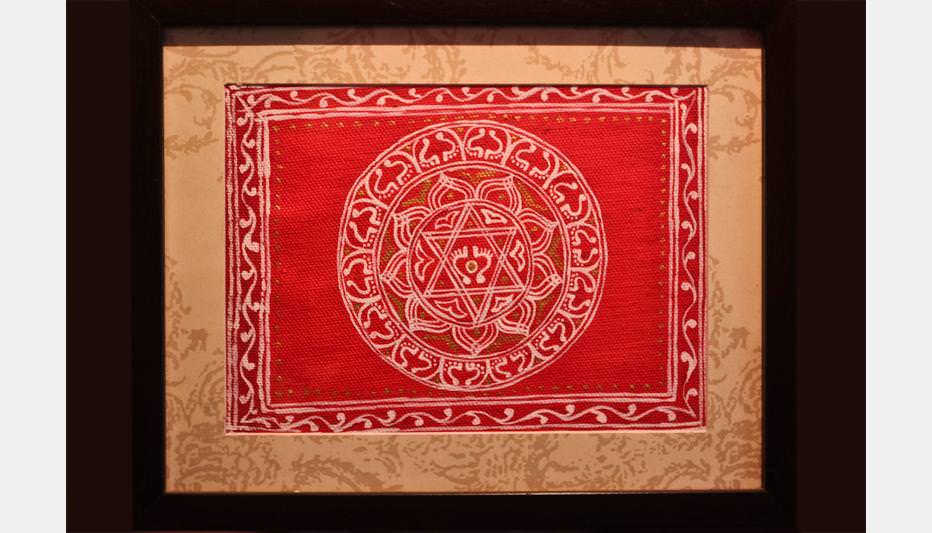“Dedicated to my childhood and to all my fellow pahadis around the world” – Kavita Adhikari
I had the opportunity to see and grow up in different parts of India and my childhood was nothing but happy and colorful. I was born in Majkhali, a small village in the Kumaon region. Born into a modest family of armed forces parents/grandparents, I remember travelling all over India almost every 2 years since the age of 7.

Kavita’s ancestral home in Majkhali, Almora

A disowned house in Majkhali
Even though I shifted base every 2 years, and currently living outside of India, my heart belongs to the mountains (the mighty pahads). Today, 30 years later, I still remember my childhood distinctively and lovingly.
This article is dedicated to all those nitty-gritty things that make our beloved mountains special, where living is none less than pure bliss.
Now this one is special and I am going to dedicate more than a bullet point for this. I remember watching my grandma and my mum making aipan on important occasions, especially during festivals and weddings. The distinct smell of wet, fresh aipan takes me back to my roots. As a child, this is my fondest memory and a special link to my hometown.

Image Src: dsource.in
As they say, art is a stress buster whether you are an artist or an art connoisseur and if you are a true blue Pahadi, you would have seen aipan at some point in your life. Aipan is the traditional art form of Kumaon region, known for its cultural and religious as well as decorative significance. It’s is an age-old tradition, an art form comprising of plain vertical lines, extensive use of dots, geometric patterns, motifs inspired by village life and most amazingly, it’s absolutely free hand. Uttaranchal is home to this beautiful art form.
Made with soaked white rice watery paste delicately designed on a geru canvas (a deep red colored soil is used as a base to create a canvas-like surface to hold the white colored designs). To put this is in context for folks residing outside Uttarakhand, the art of aipan is similar to rangoli in Maharashtra and kolam in South India. It is believed that aipan is a way to pay tribute to nature and especially to the mountain Gods that all pahadis swear by.

Src: dsource.in
Art is a constant reminder of history, of traditions and cultures. That’s why art around the world doesn’t have a set price, and in most cases it is priceless. Same goes for folk art forms like aipan. And as a pahadi, it’s our responsibility to pass this experience, knowledge to the next generation or else like many other things, this too will soon be forgotten. I will leave you with that, if you have never seen aipan or have forgotten how it looks like, google it or ask your parents/grandparents but do check it out.
Naula: an underground spring water drinking water well
Sattu: protein rich flour served as a meal to school children during lunch and sponsored by the government
Anagambadi: village preschool
Gulli-dhanda, pitthu, kanche, gucchi: all names of games played in many rural parts of India
Sana hua nimbu: a sweet and sour salad primarily made from the big lemon pulp
Dhoop: sunshine
Bhaat and bhat ki churkani: rice with black lentils soup
Namak: salt
Bhang ki chutney: chutnery made from wild cannabis seeds growing in Kumaon region Jhoras: a dance performed in a circular formation where everyone holds hands to make it like a ring
Ghughut: crow, the bird
ram-leela: village month long theatre around the Diwali festival
Gud ki chai: tea with jaggery
Chitrahar and Ramayana: popular TV shows in the late 80’s and 90’s
Note: This Article is originally written by Kavita Adhikari
Living and enjoying every bit of Uttarakhand. Its amazingly beautiful!
Wow, it’s truly amazing and a blessing to be a part of the beautiful Uttarakhand. Though I’m a non Uttarakhandi but so obsessed with it’s charm that I shifted to this awesome place last year. Experiencing all these adventurous things which you have mentioned and Learning more everyday. Thanks for sharing the details 😊
You forgot the unique colourful pichoda.
Awesome Memories, Thanks for sharing :)
Wow that’s was amazing and made me nostalgic. It’s been some time I vsisted my village i think now is the time although coming form the services I have travelled and treaded many places . But our very uttrakahand is unique in its very own way . I a have made a resolution of exploring uttrarkahand this and in the years to follow. Read it some where ” luck are those who live in mountains as they never heave to go heaven after that due.”
कविता जी प्रणाम , आपक द्वारा लिन्खी पोस्ट तै देखेकी भोत बडिया लगी ,मी भी अपर कुडी ता ई बडिया ब्नोदुल …………………
धन्यबाद l
Kudos to you. Anyone who goes through it will immediately reflect the feelings of their childhood lived in the mountain villages of Uttarakhand. What a great treasure of our childhood we cheris???
Even I was born in almora and spent my childhood in almora & haldwani and this article brought down so many childhood memory of mine, everythings which were lost inside my mind somewhere this article recall all that in a flashback. . .
Thank u so much kavita for all this. . . Great job
#KAVITA ADHIKARI , Really this took me in flash back of those amazing days which I ever wish to come back.
Thank you .